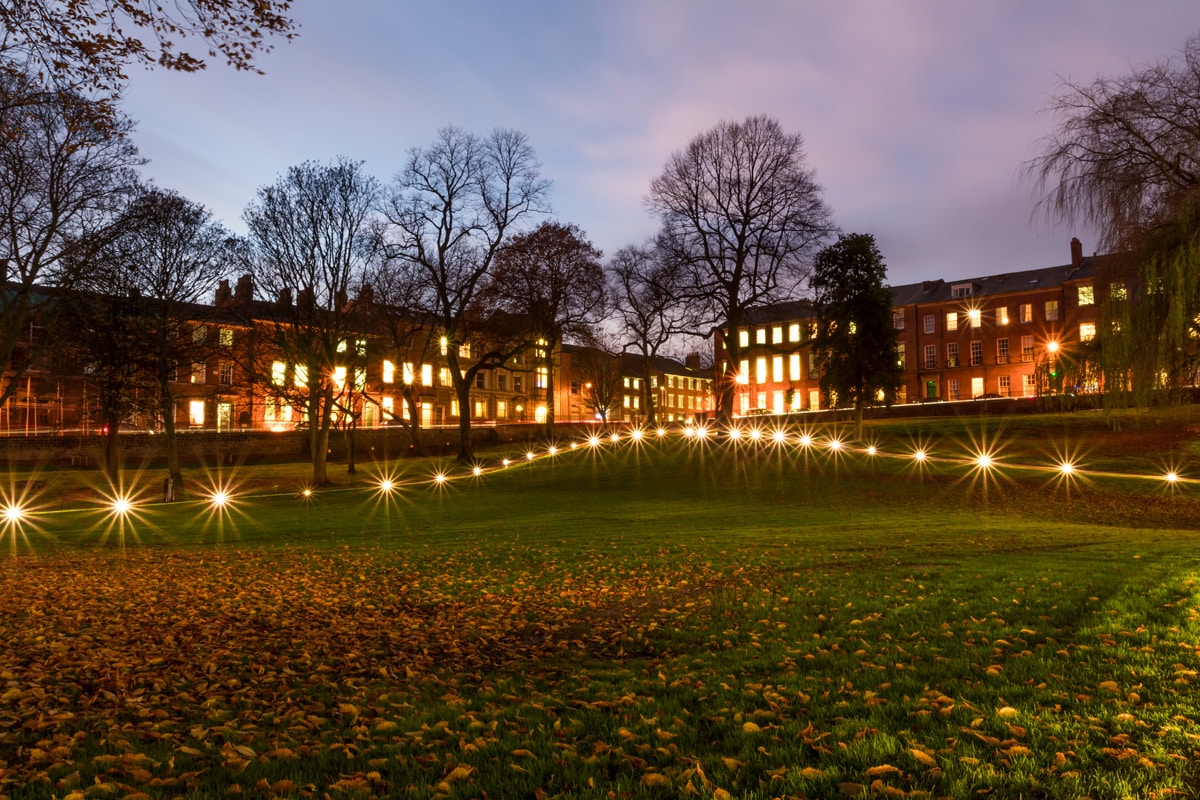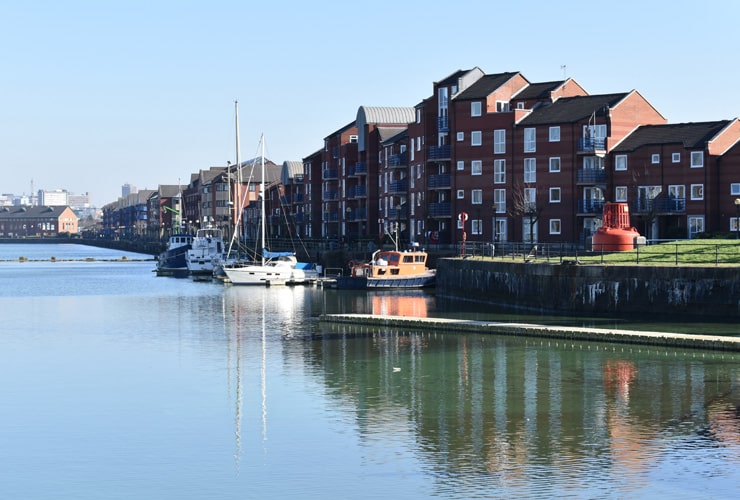Areas of Preston: Buy-to-Let Property Investment Hotspots

-
by Property Investments UK
The Property Investments UK editorial team have been researching and writing about the UK's property market for more than a decade.
The city of Preston might not be as well known – nor as big – as the North West’s main cities of Manchester and Liverpool. But Preston has been voted a better place to live and work than both of them. Preston offers affordable investment property too, so it’s easy to see why it should be on every property investor’s radar.
Contents
- 10 Reasons to Invest in Preston's Residential Property Market
- Attractions and Amenities
- Transport Links
- Property Values
- Average Property Price (Price Paid) by Postcode Area
- Rental Demand
- Average Rental Yield by Postcode Area
- Landlord Licensing
- The Best Places to Live in Preston
- Property Investment in Preston
10 Reasons to Invest in Preston's Residential Property Market
- A Large Student Population: With three universities in and around Preston, including UCLan, Lancaster University, and Edge Hill, the city has a solid student population. UCLan alone has over 38,000 students and staff, and the city's student population is expected to grow.
- A Young and Growing Population: Preston's population has grown by 5.4% between 2011 and 2021 and is projected to increase by 66% by 2041.
- High Rental Demand: Preston has a population of almost 142,000, an above-average employment rate of 83%, and a large student and young professional population. While demand outstrips supply, this creates a large and unwavering demand for rental properties.
- Attractive Rental Yields: Preston offers attractive rental yields, with an average of 4.2%, above the UK average of 3.38%. The PR1 postcode area can deliver impressive yields of up to 7.1%.
- Strong Transport Links: Preston has excellent transport connections, with two international airports within an hour's drive. The city is well-connected by road, with six major motorways providing superb access.
- A Central Location: Preston is centrally located in the UK, with Manchester and Liverpool less than an hour away by rail or road. This makes it an attractive option for commuters and those seeking cheaper living.
- A Growing Economy: Preston is a hub for high-value sectors like computing, business services, and finance. The city is committed to inclusive economic growth, ensuring that all residents benefit from investment.
- Regeneration and Development: Preston has seen significant regeneration, with projects like the £5 billion intelligence and defence unit, the UCLan Masterplan, and the Stoneygate Masterplan. These initiatives are transforming the city and boosting property prices and rents.
- Affordable Property Prices: Property prices in Preston are relatively low compared to other UK cities, and prices are rising steadily. This presents an excellent opportunity for investors to get in before prices surge.
- A High-Quality Lifestyle: Preston offers a high quality of life, scoring highly on surveys for its affordability and amenities. The city has excellent cultural and retail offerings, with a mix of national retailers, independent shops and boutiques

Attractions and Amenities
Preston has a rich cultural scene and the diverse range of amenities, you'd expect of an important city. The city is Lancashire's administrative centre, with a population of around 147,800 (Census 2021), and is home to the University of Central Lancashire, which adds a certain, youthful vibrancy to the city centre.
Preston offers a mix of shopping experiences, from big brands to boutiques and independent shops. The Fishergate Shopping Centre and St George's Shopping Centre are the main malls in the city centre, while retail parks like Deepdale Shopping Park and Capitol Centre can be found on the outskirts. The historic Covered Market and Fishmarket have been redeveloped, offering fresh local produce, hot food, and unique shopping experiences like the Box Market.
Preston also boasts a variety of cultural attractions, including the Harris Museum, Art Gallery and Library, the Lancashire Infantry Museum, and the Ribble Steam Railway. The city has over 770 Grade I and II listed buildings, as well as beautiful parks like Avenham Park and Miller Park, which rank among the finest Victorian-era parks in the country.
Transport Links
Preston has an extensive network of transport links, including road, rail, and bus. The city is served by several major roads, including the M6, M55, M65, and M61 motorways, as well as the A6, A59, and several other A roads. Preston railway station is a major West Coast Main Line station, with routes across North-West England.
It also has an extensive bus network, with Preston Bus Station claiming to be one of the biggest in Europe. There are plans to improve public transport and reduce congestion, focusing on transitioning from a car-dominated network to a multi-modal network.
There are no public airports in Preston for air travel, but there are several nearby airports, including Blackpool International Airport, Liverpool John Lennon Airport, and Manchester Airport.
Property Values
Preston offers a range of property types, from terraced houses to bungalows and flats, with prices to suit a variety of budgets. According to HM Land Registry, the average house price in Preston is £159,000 as of February 2024, though other sources give an average of £221,000 for the wider Preston area (with a median average price of £190,000) and the cheapest properties in the area, starting from around £30,000.
Preston's property market caters to a range of buyers, with the most properties sold in the £100,000-£150,000 price range, followed by the £150,000-£200,000 range.
Preston's property market has seen some fluctuations, with prices rising by 1.4% from January 2023 to January 2024.
Average Property Price (Price Paid) by Postcode Area
Last updated: April 2024
Data from HM Land Registry
| Postcode District | Average Property Price |
|---|---|
| PR1 | £209,127 |
| PR2 | £215,585 |
| PR4 | £287,581 |
| PR7 | £240,562 |
| PR8 | £242,975 |
| PR9 | £213,872 |
Rental Demand
Preston's buy-to-let market offers attractive rental yields and affordable property prices for investors. The city has a strong student population and a growing economy, with a young and growing population.
Preston's population has grown by 5.4% between 2011 and 2021, and this growth is expected to continue, with a forecast increase of 66% by 2041. The city's status as a hub for defence and aerospace industries, as well as its position as a leading tech hub, contribute to its economic growth.
The University of Central Lancashire, one of the UK's largest universities, is a significant draw for students and young professionals, with a staff and student community of 38,000. The university's £200 million Masterplan, including a new £60 million Student Centre, further enhances Preston's appeal as an educational hub.
Regeneration projects, such as the UK's £5 billion National Cyber Force Unit and the Preston Station Quarter Regeneration Framework, are transforming the city and boosting property prices and rents. The average rental yield in Preston is 4.2%, above the UK average of 3.38%.
Preston offers a range of property options, from affordable terraced houses to more expensive semi-detached family homes. The city's proximity to Manchester and Liverpool, as well as its excellent transportation links, make it an attractive hub for those seeking cheaper living in the North West.
Overall, Preston's buy-to-let market presents a mix of opportunities and challenges for investors, with strong demand from students and young professionals. There are, however, as with many places in the UK, potential difficulties arising from rising costs and legislative changes.
Average Rental Yield by Postcode Area
Rental yield is the rental return an investor can expect on their investment once costs have been taken into consideration.
Last updated: April 2024
| Postcode District | Average Rental Yield |
|---|---|
| PR1 | 6.4% |
| PR2 | 5.5% |
| PR4 | 4.3% |
| PR7 | 4.2% |
| PR8 | 4.4% |
| PR9 | 4.0% |
Landlord Licensing
Preston City Council requires all HMO landlords to have an HMO license and has rules around the modification of homes located within local, conservation areas. It is worth noting, however, that the Council are within their rights, as set out in the Housing Act 2004, to bring in a Selective Licensing Scheme at any time, as many local authorities have done over the last few years.
Selective Licensing schemes, require all private landlords to have a license (meaning they commit to certain housing standards) within specific areas and are not without controversy. As of early 2024, there is no such scheme in Preston but this could change, so it is always worth checking the council's website for any updates.
HMO Licensing
On the 1st of October, 2018, mandatory licensing for HMOs was introduced in England and Wales and so, of course, applies in Preston. A licence must be acquired and renewed for properties occupied by five or more people (from two families) who share facilities such as a kitchen or bathroom.
Failure to apply for an HMO licence can result in unlimited fines and a ban from operating rental properties in the future. The cost of an HMO licence starts at around £45 but can go up to over £1000 for a new application. Renewal fees are lower, starting at around £150.
Article 4 Directions
Article 4 Directions provide additional planning control for some areas. In Preston, this means that house frontages that face a highway or public open space within the Preston Village Conservation Area are subject to restrictions. This includes altering windows and doors, roof coverings, chimney stacks, and roof lights without first obtaining planning permission.

The Best Places to Live in Preston
Preston offers a range of desirable neighbourhoods, each with its unique character and appeal. Here are some of the best places to live in Preston:
- Cottam, Penwortham, Woodplumpton, Broughton, Fulwood, and Hutton: These areas are generally regarded as desirable, offering a mix of housing options and a strong sense of community.
- Outlying Villages: Villages on the outskirts of Preston, such as Barton, are often considered desirable, offering a more rural lifestyle while still being close to the city.
- Ashton-on-Ribble: This area provides a semi-detached suburbia and a multi-ethnic community, with house prices ranging from £50,000 to £363,000.
- Fulwood: Known for its suburban achievers and Indian tech achievers, Fulwood offers a mix of housing types, including detached retirement homes. House prices range from £62,000 to £500,000.
- Barton, Claughton: Located near Preston, Barton offers suburban achievers and detached retirement living. House prices range from £75,000 to £630,000.
- Nooklands: Nooklands presents a diverse range of housing options, from suburbanites to semi-detached suburbia. House prices vary, with the latest sold prices ranging from £16,500 to £450,000.
- Gallows Hill and Farringdon Park: These areas are known for their multicultural metropolitans and challenged Asian terraces, with Pakistani communities. House prices range from £42,500 to £750,000.
- Preston City Centre: While opinions are mixed, some find the city centre very appealing due to its convenient location and vibrant atmosphere.
Property Investment in Preston
Here’s our investor’s guide to some of the different areas in and around Preston:
Preston City Centre and Inner Suburbs
Population: 47,200
Average House Price: £138,000
Preston city centre has a small city living scene, and there are plans to build more apartment blocks and attract more city living. The old Preston docklands have been turned into a marina with residential and leisure facilities. The city centre and inner suburbs like Avenham, Broadgate, Frenchwood and Deepdale are cheap property areas, popular for a budget buy-to-let. Other areas like Plungington are popular for student accommodation.
A good property in these areas (PR1 postcode) could offer landlords strong rental yields of an average of 6.4%.
North Preston
Population: 35,350
Average House Price: £190,000 - £250,000
North Preston, including Fulwood and the adjoining small suburb of Cadley, is one of the city’s most popular residential areas. It has good local schools, shops and other amenities. The city side of Fulwood is a lower-mid priced area while the outer fringes are more upmarket residential areas. The Royal Preston Hospital is also at Fulwood, creating lots of demand from hospital staff who want to live nearby.
Further out Broughton and Woodplumpton are separate villages, both around four miles north of Preston city centre. They’re popular commuter villages and a mid-higher price area.
Yields in North Preston covered by the PR2 postcode area are a strong 5.5% on average while in PR3, further out, around 4% is more likely.
East Preston
Population: 8,500
Average House Price: £140,000 - £160,000
Suburbs here include Ribbleton, a large east Preston suburb with its own shops and amenities, Fishwick and Grange. The area is partly residential and partly commercial area with several business parks and large employers providing lots of jobs. East Preston is generally is a lower-priced property area and offers good value for buy-to-let investors.
Yields in this area (PR2) are, on average, 5.5%.
South Preston
Population: 42,100
Average House Price: £170,000 - £210,000
South of Preston city centre, across the River Ribble, there are a number of different communities which are mainly in the Borough of South Ribble rather than the city itself.
Areas here include Bamber Bridge, Lostock Hall, Tardy Gate and Walton-le-Dale. All are popular mid-priced residential areas with good local amenities. They attract both those who work in Preston as well as commuters thanks to their proximity to the M6, M61 and M65, and so are strong areas for buy to let investors.
Penwortham is a separate small town, just to the southwest of Preston city centre across the River Ribble, and also in the Borough of South Ribble. Penwortham has great city-centre access and is popular with Preston commuters and also with families. It’s also a mid-priced property area.
This area is covered by the PR1 postcode where up to 7% yield is possible but is mostly in PR5 where 4% yield is more usual.
West Preston
Population: 17,400
Average House Price: £120,000 - £250,000
West Preston includes suburbs such as Ashton on Ribble (often known simply as Ashton), Savick, Lea, Larches, Callon, Cottam, Ingol and Tanterton. West Preston offers a range of housing types: The inner areas are cheap property areas for investors while the outer areas are more villagey in nature and are mid-higher priced property areas.
One thing investors should know about the west side of Preston: Funding has just been confirmed for the new Preston Western Distributor road connecting the M55 and A583 on the west side of the city. The new road will open up land for new housing developments and new commercial developments in this part of the Preston area.
Yields in west Preston, mostly in PR2, are around 5.5% on average.